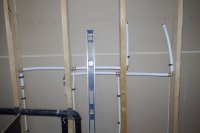Yukoner777
Member
Hi there
After having the plumbing roughed in for fourteen years, I'm finally going to finish the ensuite bathroom. It will have a 4' x 4' shower. Originally it was going to be bigger, with dual showers. But now I plan to have an 8" or 10" rain head and a slide bar mounted shower sprayer.
So I've got two 1/2" hot and two 1/2" cold pex lines for the shower. Recently, I teed them so that I now have one 3/4" hot and one 3/4" cold pex line. [see pic]
I thought that I'd use a 3/4" valve for temp control, but from what I've found, the 3/4" valves only have inlets and outlets for metal pipe [IPS on the Moen ExactTemp 3/4" Thermostatic Valve]. Is there a way for me to use the pex pipe on a 3/4" valve?
Alternatively, would it be better for me to utilize all four 1/2" pex lines by having a separate valve for the rain shower head and a separate one for the sprayer?
I'd also like to have volume controls for both heads.
Thanks
Ross
After having the plumbing roughed in for fourteen years, I'm finally going to finish the ensuite bathroom. It will have a 4' x 4' shower. Originally it was going to be bigger, with dual showers. But now I plan to have an 8" or 10" rain head and a slide bar mounted shower sprayer.
So I've got two 1/2" hot and two 1/2" cold pex lines for the shower. Recently, I teed them so that I now have one 3/4" hot and one 3/4" cold pex line. [see pic]
I thought that I'd use a 3/4" valve for temp control, but from what I've found, the 3/4" valves only have inlets and outlets for metal pipe [IPS on the Moen ExactTemp 3/4" Thermostatic Valve]. Is there a way for me to use the pex pipe on a 3/4" valve?
Alternatively, would it be better for me to utilize all four 1/2" pex lines by having a separate valve for the rain shower head and a separate one for the sprayer?
I'd also like to have volume controls for both heads.
Thanks
Ross



